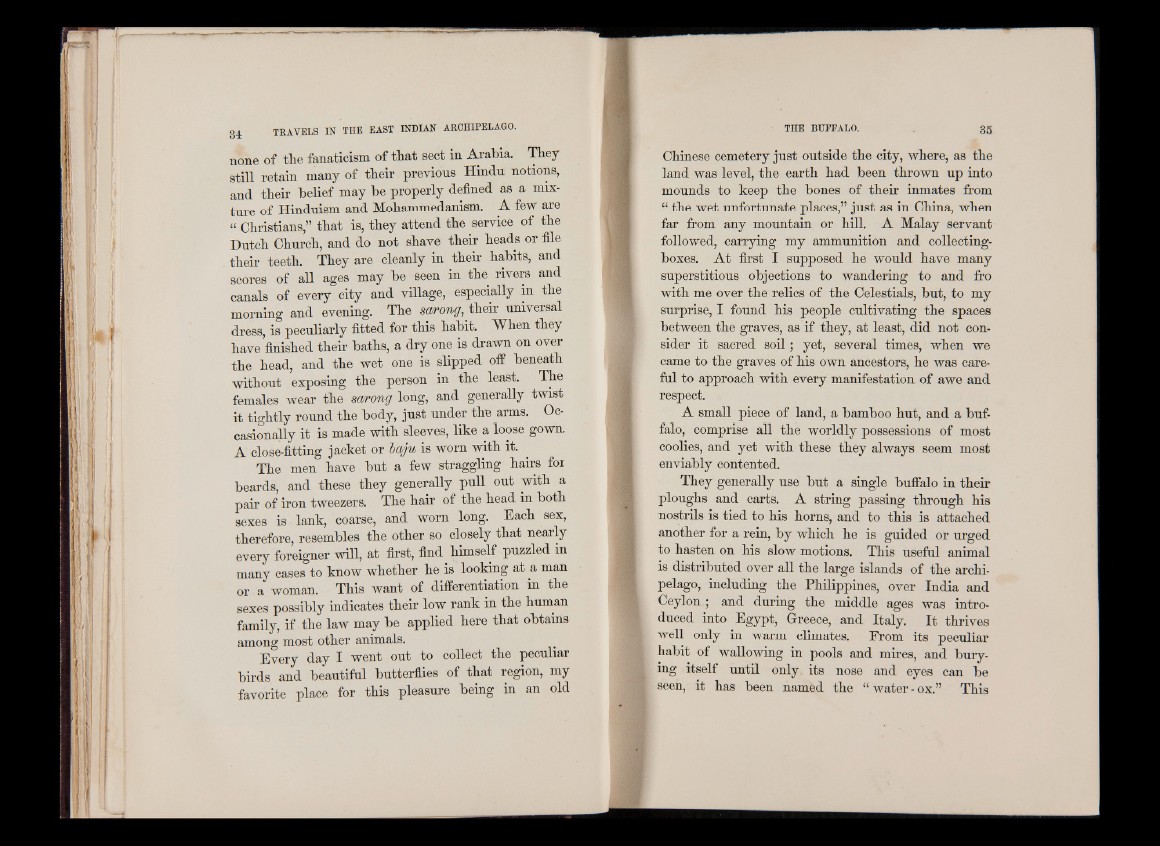
34: TRAVELS IN THE EAST INDIAN ARCHIPELAGO.
none of the fanaticism of that sect in Arabia. They
still retain many of their previous Hindu notions,
and their belief may be properly defined as a mixture
of Hinduism and Mohammedanism. A few are
“ Christians,” that is, they attend the service of the
Dutch Church, and do not shave their heads or file
their teeth. They are cleanly in their habits, and
scores of all ages may be seen in the rivers and
canals of every city and village, especially in the
morning and evening. The sarong, their universal
dress, is peculiarly fitted for this habit. When they
have finished their baths, a dry one is drawn on over
the head, and the wet one is slipped off beneath
without exposing the person in the least. The
females wear the sarong long, and generally twist
it tightly round the body, just under the arms. Occasionally
it is made with sleeves, like a loose gown.
A close-fitting jacket or laju is worn with it. ^
The men have but a few straggling hairs for
beards, and these they generally pull out with a
pair of iron tweezers. The hair of the head in both
sexes is lank, coarse, and worn long. Each sex,
therefore, resembles the other so closely that nearly
every foreigner will, at first, find himself puzzled in
many cases to know whether he is looking at a man
or a woman. This want of differentiation in the
sexes possibly indicates their low rank in the human
family, if the law may be applied here that obtains
among most other animals.
Every day I went out to collect the peculiar
birds and beautiful butterflies of that region, my
favorite place for this pleasure being in an old
THE BUFFALO. 35
Chinese cemetery just outside the city, where, as the
land was level, the earth had been thrown up into
mounds to keep the bones of their inmates from
“ the wet unfortunate places,” just as in China, when
far from any mountain or hill. A Malay servant
followed, carrying my ammunition and collecting-
boxes. At first I supposed he would have many
superstitious objections to wandering to and fro
with me over the relics of the Celestials, but, to my
surprise, I found his people cultivating the spaces
between the graves, as if they, at least, did not consider
it sacred soil; yet, several times, when we
came to the graves of his own ancestors, he was careful
to approach with every manifestation of awe and
respect.
A small piece of land, a bamboo hut, and a buffalo,
comprise all the worldly possessions of most
coolies, and yet with these they always seem most
enviably contented.
They generally use but a single buffalo in their
ploughs and carts. A string passing through his
nostrils is tied to his horns, and to this is attached
another for a rein, by which he is guided or urged
to hasten on his slow motions. This useful animal
is distributed over all the large islands of the archipelago,
including the Philippines, over India and
Ceylon ; and during the middle ages was introduced
into Egypt, Greece, and Italy. I t thrives
well only in warm climates. From its peculiar
habit of wallowing in pools and mires, and burying
itself until only its nose and eyes can be
seen, it has been named the “ water-ox.” This